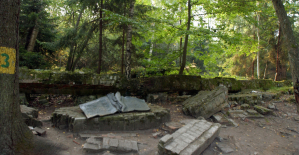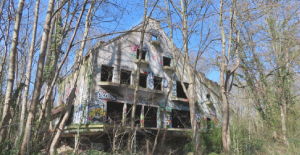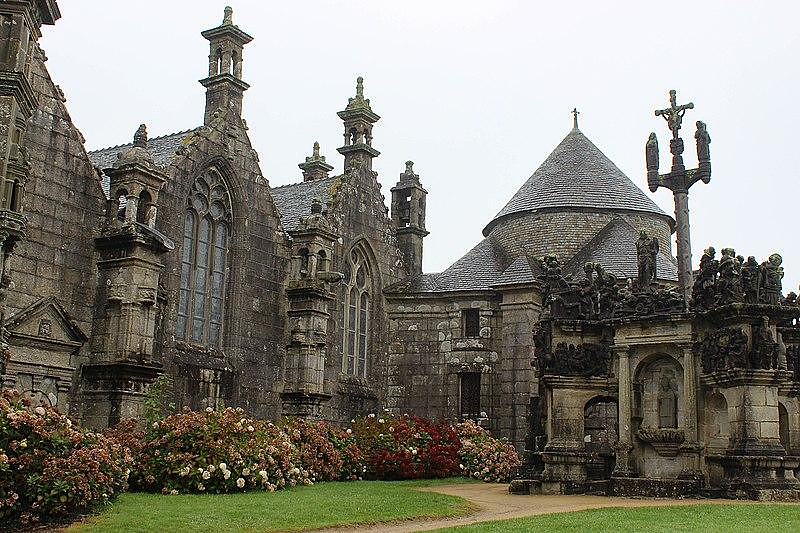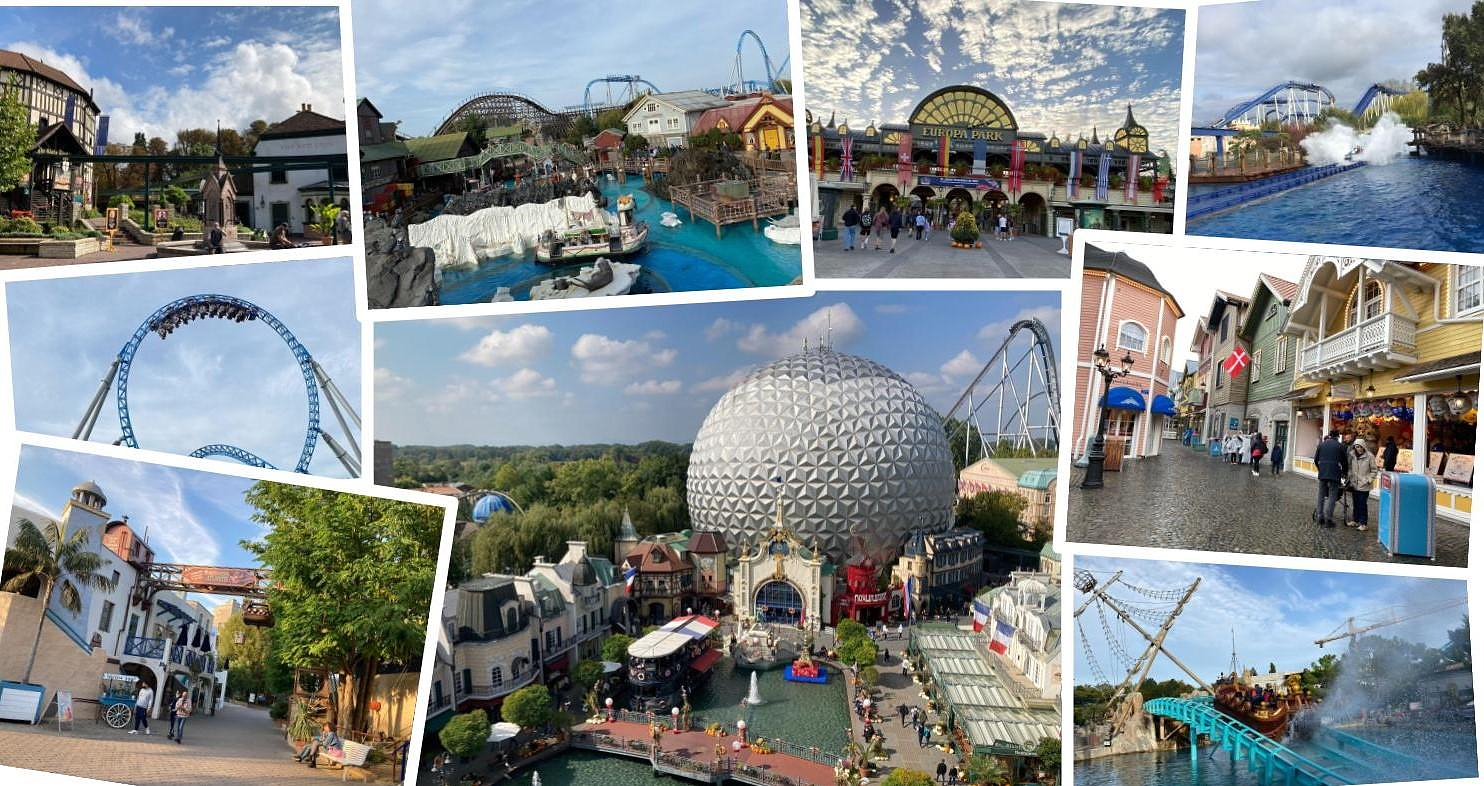The parish enclosures, architectural ensembles typical of Brittany in the 16th and 17th centuries, have taken an important step towards being classified as a UNESCO world heritage site, announced the holders of the application file.
Launched two years ago, this inscription project was retained on the indicative list of French properties as possible candidates for UNESCO world heritage, announced the president of the Finistère department Maël de Calan (various right), Friday during of a press conference. “We have taken a first and formidable step, which makes us official candidates of France,” he said. “It’s a decisive step,” added former Minister of Culture Jean-Jacques Aillagon, president of the mission responsible for carrying out the candidacy, who stressed that this step generally took “six or seven years, and for some others more than ten years.”
Architectural groups composed in particular of a church, an enclosure wall, a monumental door, a calvary or a cross, a plaister (enclosed ground) and an ossuary, the parish enclosures are characteristics of Lower Brittany. Out of around a hundred sites listed, the mission selected 31 because of their state of conservation and their integrity. This list should be gradually reduced to around fifteen particularly remarkable enclosures.
This architectural heritage belongs to the history of the golden age of Brittany (1500-1700), based on maritime trade and the production of linen fabrics for clothing, exported to England and Spain. It is in this context of economic prosperity, coupled with a “particular religious fervor” that these enclosures will be built, according to Jean-Jacques Aillagon. A magnificent work by Hervé Quéméner and Jean-Yves Guillaume, published by Georama editions, lists this heritage of the Breton golden centuries. Places of worship scattered on either side of the Élorn valley, a river which flows into the Arrée mountains, crosses Sizun and Landerneau before flowing into Brest Harbour.
“There is still a lot of work to be done. I am hopeful that, with this work accomplished, we will ultimately succeed in including the parish enclosures on the world heritage list,” assured the former minister of Jacques Chirac. “World Heritage means that we will find ourselves in the same category as the pyramids of Giza or the Parthenon of Athens,” he underlined.
Without waiting for this registration, which will take at least four years, work potentially reaching several tens of millions of euros will be scheduled to restore the main enclosures.
In October 2022, France's indicative list included 33 sites, according to the UNESCO website. Some have been there since 1996, such as the megaliths of Carnac, whose world heritage listing is expected in 2025 or 2026, according to the mayor of the Breton town.

 Who was Dror Or, the Israeli father who died as a hostage in the hands of Hamas?
Who was Dror Or, the Israeli father who died as a hostage in the hands of Hamas? “Pay in cash”: at his trial, Donald Trump faced with an embarrassing recording
“Pay in cash”: at his trial, Donald Trump faced with an embarrassing recording Italy: a grandmother accidentally serves a bottle filled with wine to a baby, he has an alcoholic coma
Italy: a grandmother accidentally serves a bottle filled with wine to a baby, he has an alcoholic coma The mysterious skeletons of Hermann Göring's villa
The mysterious skeletons of Hermann Göring's villa Children born thanks to PMA do not have more cancers than others
Children born thanks to PMA do not have more cancers than others Breast cancer: less than one in two French women follow screening recommendations
Breast cancer: less than one in two French women follow screening recommendations “Dazzling” symptoms, 5,000 deaths per year, non-existent vaccine... What is Lassa fever, a case of which has been identified in Île-de-France?
“Dazzling” symptoms, 5,000 deaths per year, non-existent vaccine... What is Lassa fever, a case of which has been identified in Île-de-France? Sánchez cancels his agenda and considers resigning: "I need to stop and reflect"
Sánchez cancels his agenda and considers resigning: "I need to stop and reflect" Health carpooling, this source of savings which arouses the ire of patients and taxis
Health carpooling, this source of savings which arouses the ire of patients and taxis Tesla Model 3, MG4 and Dacia Spring.... With the end of the ecological bonus, these electric cars produced in China are seeing their sales fall
Tesla Model 3, MG4 and Dacia Spring.... With the end of the ecological bonus, these electric cars produced in China are seeing their sales fall For the 2024 Olympics, Airbnb commits to fighting prostitution in its accommodation
For the 2024 Olympics, Airbnb commits to fighting prostitution in its accommodation “Shrinkflation”: supermarkets obliged to alert their customers from July 1
“Shrinkflation”: supermarkets obliged to alert their customers from July 1 The electro of Justice and the echoes of Portishead
The electro of Justice and the echoes of Portishead 1924 Olympic Games: according to his daughter, the hero of Chariots of Fire was “not a bigot”
1924 Olympic Games: according to his daughter, the hero of Chariots of Fire was “not a bigot” The “German Brothel” in Yvelines: an uncertain future for the ruined residence
The “German Brothel” in Yvelines: an uncertain future for the ruined residence The eye of the INA: when Paul Auster visited Bernard Pivot
The eye of the INA: when Paul Auster visited Bernard Pivot Omoda 7, another Chinese car that could be manufactured in Spain
Omoda 7, another Chinese car that could be manufactured in Spain BYD chooses CA Auto Bank as financial partner in Spain
BYD chooses CA Auto Bank as financial partner in Spain Tesla and Baidu sign key agreement to boost development of autonomous driving
Tesla and Baidu sign key agreement to boost development of autonomous driving Skoda Kodiaq 2024: a 'beast' plug-in hybrid SUV
Skoda Kodiaq 2024: a 'beast' plug-in hybrid SUV The home mortgage firm rises 3.8% in February and the average interest moderates to 3.33%
The home mortgage firm rises 3.8% in February and the average interest moderates to 3.33% This is how housing prices have changed in Spain in the last decade
This is how housing prices have changed in Spain in the last decade The home mortgage firm drops 10% in January and interest soars to 3.46%
The home mortgage firm drops 10% in January and interest soars to 3.46% The jewel of the Rocío de Nagüeles urbanization: a dream villa in Marbella
The jewel of the Rocío de Nagüeles urbanization: a dream villa in Marbella Facing Jordan Bardella, the popularity match turns to Gabriel Attal’s advantage
Facing Jordan Bardella, the popularity match turns to Gabriel Attal’s advantage Europeans: a senior official on the National Rally list
Europeans: a senior official on the National Rally list Blockade of Sciences Po: the right denounces a “drift”, the government charges the rebels
Blockade of Sciences Po: the right denounces a “drift”, the government charges the rebels Even on a mission for NATO, the Charles-de-Gaulle remains under French control, Lecornu responds to Mélenchon
Even on a mission for NATO, the Charles-de-Gaulle remains under French control, Lecornu responds to Mélenchon These French cities that will boycott the World Cup in Qatar
These French cities that will boycott the World Cup in Qatar Monaco - Clermont: Minamino cornerstone, Fofana essential, the Clermont defense overwhelmed... The tops and the flops
Monaco - Clermont: Minamino cornerstone, Fofana essential, the Clermont defense overwhelmed... The tops and the flops Gymnastics: two gold medals for the Italian Manila Esposito during the European Championships
Gymnastics: two gold medals for the Italian Manila Esposito during the European Championships Champions Cup: in pain, Leinster beats Northampton and qualifies for the final
Champions Cup: in pain, Leinster beats Northampton and qualifies for the final Liga: Real Madrid crowned champion of Spain after FC Barcelona's defeat in Girona
Liga: Real Madrid crowned champion of Spain after FC Barcelona's defeat in Girona


















